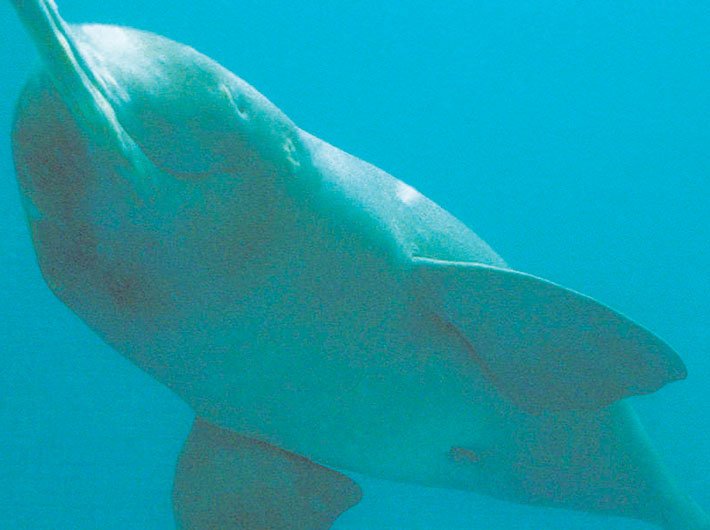UP census of the Ganga Dolphins shows increase in numbers but threats to them are increasing too
If the dolphins are alive and breeding then the Ganges is not dead. Yet, according to a census undertaken by the Uttar Pradesh forest department and the World Wide Fund for Nature, India, in early October, as many as 1,263 dolphins were found in a stretch of over 3,000 km in the Ganges.
Considering the fact that in the previous census of the same area (2012) only 600-odd dolphins were sighted this should be good news. But is it time to celebrate?
Before going into dreary regions of doubt, the very idea of a head count of one of the most alluring aquatic creatures is thrilling to anyone whose only acquaintance with dolphins is through endearing cartoon clips or as exotic creatures used in exotic lands to lure tourists. Or, maybe even through the more exotic singing creatures of the Greek mythology, cohabiting with gods.
That they used to be endemic to the rivers in Nepal and Bangladesh is a fact now consigned to history. What little remains of them in these parts are found in the Ganges and its tributaries.
So how exactly do you count dolphins? Err, do we go by the music the dolphins are famed to make?
Prashant Verma, chief conservator of forests in Uttar Pradesh who led this bold initiative, says that all they did was to follow the census protocol developed by the International Union for Conservation of Nature (IUCN).
It is not really rocket science. What the protocol requires is that there be four observers in a boat and if one of them sights a dolphin he calls out and if the other three agree to have seen it too, then there is a consensus. In many cases just one observer sights it and the other three fail to see it. And these are recorded as the ‘least counts’. If the first observer finds more than one at a time and these are missed or not seen by the others then these are also recorded separately as ‘highest counts’.
Of course, what is accepted among these three categories of counts is only the ‘consensus count’.
So, in 3,035 km of the Ganges and its tributaries, which the forest department’s boats combed for dolphins, 1,263 dolphins were sighted in consensus count or ‘best call’ as they are called in the jargon of the dolphin demographers.
The census conducted by the Uttar Pradesh government is the second in three years. The first one was done in 2012 and almost exactly half the numbers of the current count were found then. In 2012 only 2,500 km were covered which could explain the increase in numbers now.
The protocol for counting dolphins is based on the fact that dolphins are mammals and need to come out of the water to breathe. And the modes of their jumps have been minutely studied and recorded. The protocol has been developed based on these observations. The angles of sightings differ. Some sightings are of the tail, others of part of the body. At least 15 sighting types have been documented and the census team has to categorise their sightings using these types.
The other difficulty in counting the dolphins is their speed. They move at a speed of three kilometres per hour. Hence the 60 boats which did the census had to move at six to seven kilometres an hour to avoid duplication of sightings, says Verma.
The dolphins are often linked to music and in many countries they are trained to produce a kind of music to amuse spectators.
But this music is nothing but the sole defence mechanism of these sightless creatures who find their way through their watery world with the help of the sonar rays in what is termed as echo location.
The high frequency sound waves emitted by them hit any object, either their threats or their prey, and are reflected back to them informing them whether they should move forward and grab their prey or make a quick retreat.
But the tragedy of these creatures, called ‘soon’ in Hindi and regarded as mythological carriers of the Ganga, is that fishermen are using cheap nylon nets which do not reflect their sound waves. So, dolphins, who otherwise could easily make out the traditional nets, are getting ensnared in these nylon nets. They suffocate to death.
Verma agrees that pollution, dams, hydroelectric plants and linking of rivers pose a series of threats to the future of the dolphin. But he says that the least that the census is expected to do is to create awareness to stop usage of nylon nets.
According to Suresh Babu, director- rivers, wetlands and water policy at WWF, India, which sponsored the census as part of its long-term dolphin conservation plans, the dolphins are somewhat protected from the filth in the river as they don’t depend on the oxygen in the water. They jump out to breathe unlike fish which die if the rivers are too polluted and drained of oxygen.
Hence, the survival of the dolphins is no indication of the ecological health of the river. The WWF and the UP forest department are therefore now concentrating on just saving the dolphins by looking at issues that can be resolved locally; building awareness among fishermen against use of the nylon net.
But the larger issue that is going to be the death knell for the dolphins is the fragmentation of their habitat. This can happen with projects of river-linking as the one proposed for the Ken and Betwa rivers. Not a single dolphin showed up in the last census in Ken but this time there was one sighting. Another threat for the dolphins is the water transportation project. Both WWF and the forest department agree that it is not a
good idea but they shrug helplessly.
The latest census covered newer terrains not covered last time. A new stretch of 130 km near the Bihar border yielded 269 sightings, which, Babu and Verma say, is great news and signifies that dolphins are capable of migrating to safer zones and can withstand ecological fluctuations.
“River linking project is a threat to dolphins”
Excerpts from an interview with Prashant Verma, chief conservator of forests, Government of Uttar Pradesh:
You have followed the IUCN protocol for the dolphin census. What are the chances of an inflated figure?
The protocol, if strictly followed, does not leave any scope for inflated numbers. We go by consensus sightings by four observers in each boat that takes part in the census. By that process we have sighted 1,263. Yes, there is a 5-10 percent chance of dolphins being missed as they may have jumped or dived before the arrival of our boat or would have dived after our boat has left. So the actual numbers could be anything between 1,300 and 1,400.
Is pollution the main cause for the long-term decline in numbers?
It is a major cause as are the rest like damming, irrigation canals and any activity that leads to fragmentation of their habitat.
What about the linking of the Ken and Betwa rivers? Will that harm the dolphins?
Certainly. Linking of rivers leads to mixing of two different water types. A polluted river can pollute a clean one. And it can also lead to fragmentation of the habitat of the dolphins hastening their end.
What about dams and hydropower plants?
Reduction of water levels is harmful for their survival as it is for the river itself. Even irrigation leads to diversion of the river to canals and there is the grave danger of dolphins getting diverted to these canals leading to their deaths. Recently two dolphins were rescued from the Sharada canal which carries water for irrigation.
So have you given any recommendations to the government?
We can’t stop dams or other projects. Our main goal was to create awareness so that at least dolphins can be saved from nylon nets cast by fishermen.
What about the music they make? Did anyone hear them sing?
It is high-frequency sound waves they emit which human beings call music. We cannot hear it. It is the basic sense of perception for these creatures. They have no eyes and they can sense other objects only through the reflection of their sounds from other objects. It is called echo location. Some people have trained dolphins making them modulate their sound waves in a way that sounds musical to human ears. But otherwise it is not audible.
Menon is a freelance journalist
(The article and the interview appear in the November 16-30, 2015 issue)

